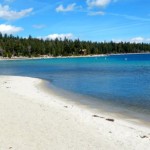Lake Tahoe clarity improves substantially
Drought is a good thing for Lake Tahoe’s clarity.
This was proved with today’s announcement that the largest gain in clarity in more than a decade occurred in 2014. A disc that looks like a white dinner plate could be seen to a depth of 77.8 feet, an increase of 7.5 feet.
The Secchi disk has been used for decades to measure lake clarity. It’s dropped over the side of a boat at various locations and then someone eyeballs how far they can clearly see it. The deepest point was 93.5 feet on July 7, and the lowest was 57.4 feet on Sept. 16.

Annual average clarity readings since 1997:
• 2014: 77.8 feet
• 2013: 70.2 feet
• 2012: 75.3 feet
• 2011: 68.9 feet
• 2010: 64.4 feet
• 2009: 68.1 feet
• 2008: 69.6 feet
• 2007: 70.1 feet
• 2006: 67.7 feet
• 2005: 72.4 feet
• 2004: 73.6 feet
• 2003: 71 feet
• 2002: 78 feet
• 2001: 73.6 feet
• 2000: 67.3 feet
• 1999: 69 feet
• 1998: 66.1 feet
• 1997: 64.1 feet
Source: TERC
“While these latest data are very reassuring, they should not be interpreted as victory in our joint restoration efforts,” Geoff Schladow, director of the UC Davis Tahoe Environmental Research Center, said in a statement. “Complete restoration is still decades away, and some of the greatest challenges still lie ahead of us. We are enduring drier and warmer conditions than we have ever encountered, and the restoration consequences of that are still far from understood.”
In light winters there is less runoff into the lake. This means less sediment to cloud the water. Warmer temps also means the lake water is mixing less; this also is good for clarity. (It also brings a whole different set of ecological issues.)
Researchers provided measurements for winter (December–March) and summer (June–September). Winter clarity last year improved by 1 foot. The winter average of 78.7 feet was well above the worst winter average, 66.6 feet seen in 1997. The largest improvement was seen in summer clarity, where there was a 13-foot improvement over the preceding year. At 78.7 feet this is the highest value since 2002.
Scientists are also giving credit for the improvement to the entities working to curtail sediments from reaching the lake. This is through the total maximum daily load and environmental improvement programs. More than $1 billion has been spent in the last decade on projects related to Lake Tahoe’s clarity.
In 1968, the disk could be seen to 102.4 feet. Efforts are under way to get back to that level, but it’s not expected to happen for more than a half century.
— Lake Tahoe News staff report



This is just the middle of the Lake. We all see what’s happening near the shoreline, and the TMDL does very little for that. Doing so would interfere with all of the big development plans to put more buildings closer to Lake Tahoe (more profits, of course). Hopefully visitors will be able to look past the green and brown shoreline to enjoy the blue middle of the Lake. Oh wait, they will, thanks to the new taller buildings allowed by TRPA!
TRPA needs to crack down on all the lakefront lawns and gardens that folks dump fertilizer on.
J&B,Well said. I hope they take measurements before and after the Edgewood project. It would be interesting to see how that construction on the lakeshore affects the lakes clarity.
With the receding lake level the shoreline is looking pretty bad.
At least we are getting a little snow today. More on the way? Hopefully ! !OLS
More likely, the lake is clearer because it is below it’s natural rim, so they aren’t constantly changing the level with the Tahoe City Dam. Changing the lake level constantly can’t be good for the clarity.
The shoreline is a mess, but I think all the algae and goo is just because the lake is so low. During a drought, the water gets shallower near the shore, and consequently, it warms up, providing ideal conditions for all that gross slime to grow. Let’s hope we get some water soon!
greengrass
Should we spend another billion or two billion or how about three billion? At some point the clarity we have is probably good enough.
The lake is clearer because there is less run off from streams because of the drought
‘Tahoe Resident’:
Mr. Schadlow is correct in being ‘tentative’ with his comment, as the near-shore is now not the regular shoreline – as most of the particulates are also provided in the near-shore environment (i.e., the roads), the sediment is now deposited in the soil, not the deep water, deep enough to actually take a Secchi reading. . .so, on it goes. . .